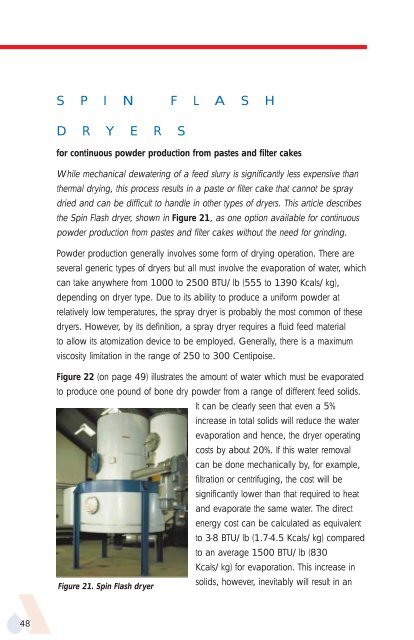APV Dryer Handbook - Umbc
APV Dryer Handbook - Umbc
APV Dryer Handbook - Umbc
You also want an ePaper? Increase the reach of your titles
YUMPU automatically turns print PDFs into web optimized ePapers that Google loves.
48<br />
S P I N F L A S H<br />
D R Y E R S<br />
for continuous powder production from pastes and filter cakes<br />
While mechanical dewatering of a feed slurry is significantly less expensive than<br />
thermal drying, this process results in a paste or filter cake that cannot be spray<br />
dried and can be difficult to handle in other types of dryers. This article describes<br />
the Spin Flash dryer, shown in Figure 21, as one option available for continuous<br />
powder production from pastes and filter cakes without the need for grinding.<br />
Powder production generally involves some form of drying operation. There are<br />
several generic types of dryers but all must involve the evaporation of water, which<br />
can take anywhere from 1000 to 2500 BTU/lb (555 to 1390 Kcals/kg),<br />
depending on dryer type. Due to its ability to produce a uniform powder at<br />
relatively low temperatures, the spray dryer is probably the most common of these<br />
dryers. However, by its definition, a spray dryer requires a fluid feed material<br />
to allow its atomization device to be employed. Generally, there is a maximum<br />
viscosity limitation in the range of 250 to 300 Centipoise.<br />
Figure 22 (on page 49) illustrates the amount of water which must be evaporated<br />
to produce one pound of bone dry powder from a range of different feed solids.<br />
It can be clearly seen that even a 5%<br />
increase in total solids will reduce the water<br />
evaporation and hence, the dryer operating<br />
costs by about 20%. If this water removal<br />
can be done mechanically by, for example,<br />
filtration or centrifuging, the cost will be<br />
significantly lower than that required to heat<br />
and evaporate the same water. The direct<br />
energy cost can be calculated as equivalent<br />
to 3-8 BTU/lb (1.7-4.5 Kcals/kg) compared<br />
to an average 1500 BTU/lb (830<br />
Kcals/kg) for evaporation. This increase in<br />
Figure 21. Spin Flash dryer<br />
solids, however, inevitably will result in an











